[ad_1]
If you don’t know what it is, DON’T EAT IT! I know I’m sounding like a broken record, but it’s something that cannot be stressed enough. There are many types of berries in the wilderness and many of them are edible – with certain precautions taken.
On the other hand, there are just as many inedible, poisonous berries in the wild; things that will negatively affect your body.
These poisonous fruits will have varying effects ranging from mild discomfort to…well…death. Many of them are attractive-looking things which could easily be mistaken for something safe to eat.
This mistake can have serious consequences. With that in mind, let’s take a look at 27 wild berries that are poisonous.
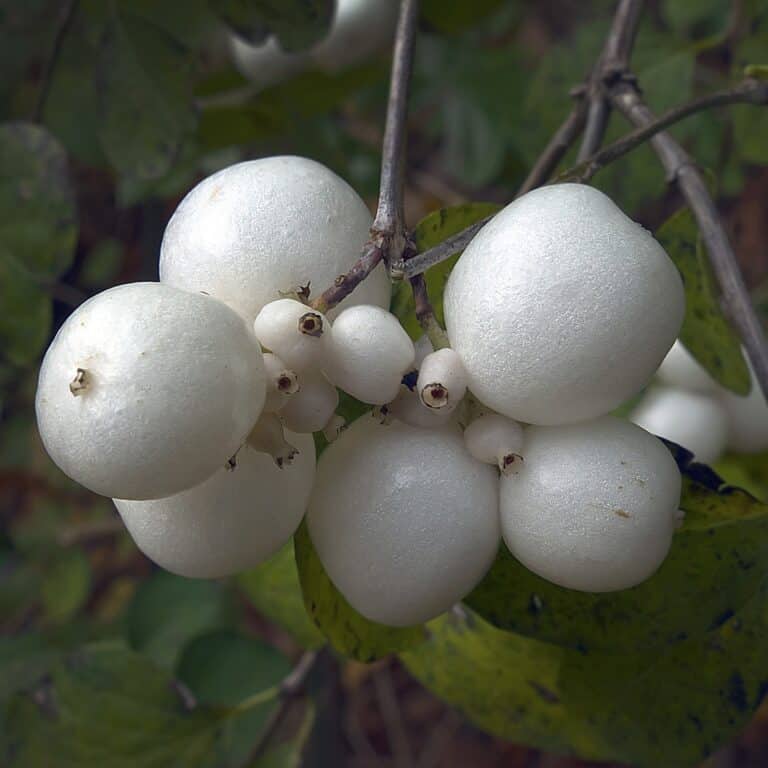
1. Common Snowberries (Symphoricarpos Albus)
Symphoricarpos albus, the common snowberry is a member of the honeysuckle family found in Northern and Western USA and much of Canada. It’s a plant that’s used for erosion control, and was a popular ornamental plant from the 1890s to the 1920s.
The common snowberry is used as a food source for bighorn sheep, grizzly bears, and white-tailed deer. It’s also eaten by certain livestock animals (i.e. cattle and sheep). With all that said, both the plants themselves and the stems are poisonous to humans and cause vomiting.
Interestingly the Native Americans used this plant as medicine and soap while they used the wood for arrow shafts.
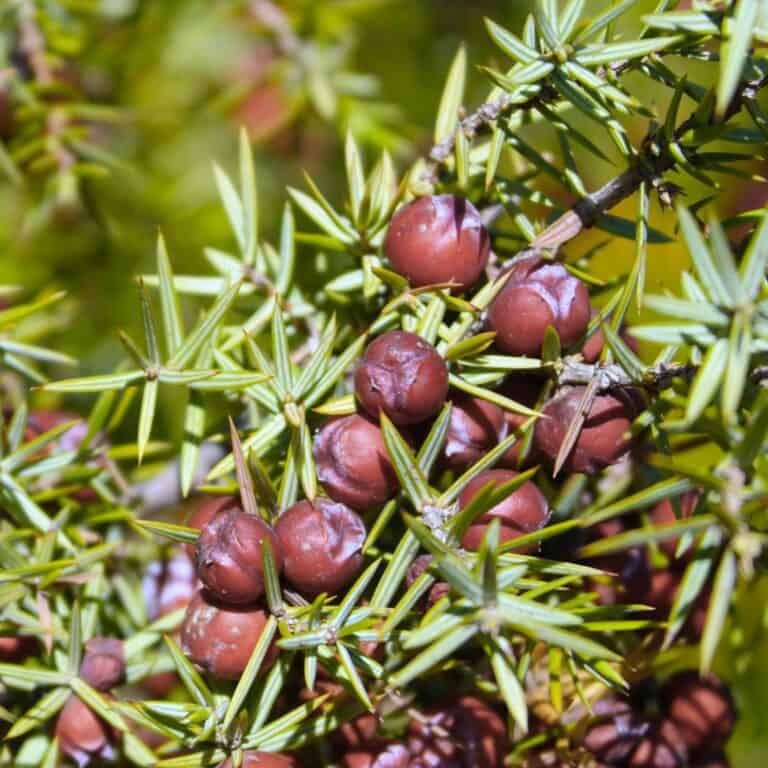
2. Juniper Berries (Juniperus Sabina)
There are a few different species of juniper plants and while there are a few that are edible; most are poisonous. Juniperus sabina – the Savin Juniper – contains savin oil which destroys the body’s cells and results in fatalities.
Additionally, all juniper plants contain thujone oil which causes diarrhea, stomach pain, and kidney damage. Juniper berries can also cause vomiting, convulsions, skin rashes, and breathing difficulties.
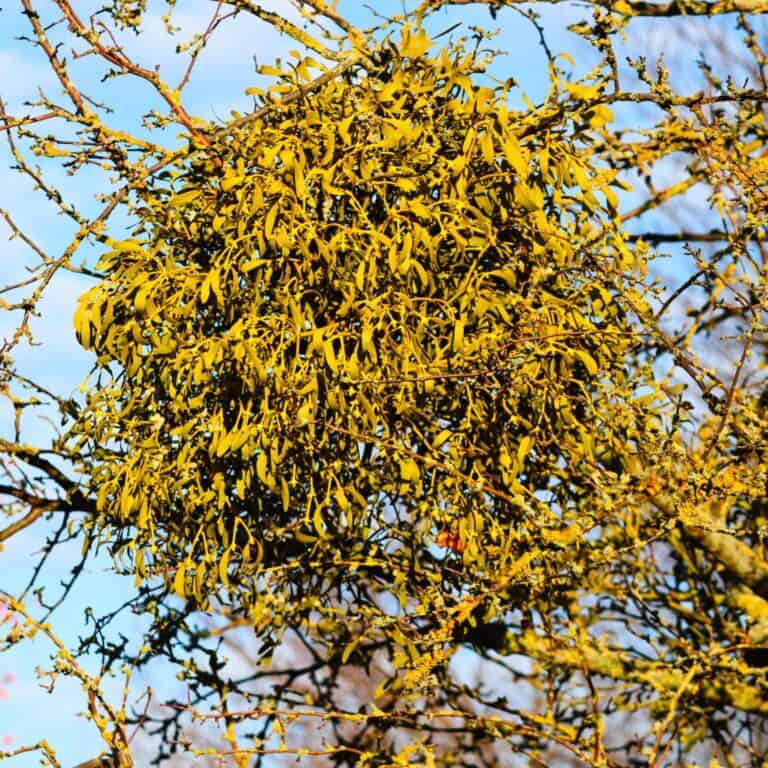
3. Mistletoe (Viscum Album)
Originally native to Europe, mistletoe plants can now be found in North Africa, Morocco, Portugal, Spain, and parts of the USA (California).
There are some 1500 species of mistletoe plants, and each one is different in terms of its toxicity to us. Viscum album – the European mistletoe is more toxic than its American counterpart (Phoradendron Leucarpum).
The American variant contains Phoratoxin and the European variant contains Tyramine. While the effects aren’t usually fatal, they aren’t pleasant. Effects include blurred vision, nausea, and vomiting. In some rare cases, they can also cause seizures, hypertension, and cardiac arrest.
These toxins are concentrated in the leaves and berries of the plants which makes it particularly dangerous to make teas out of them.
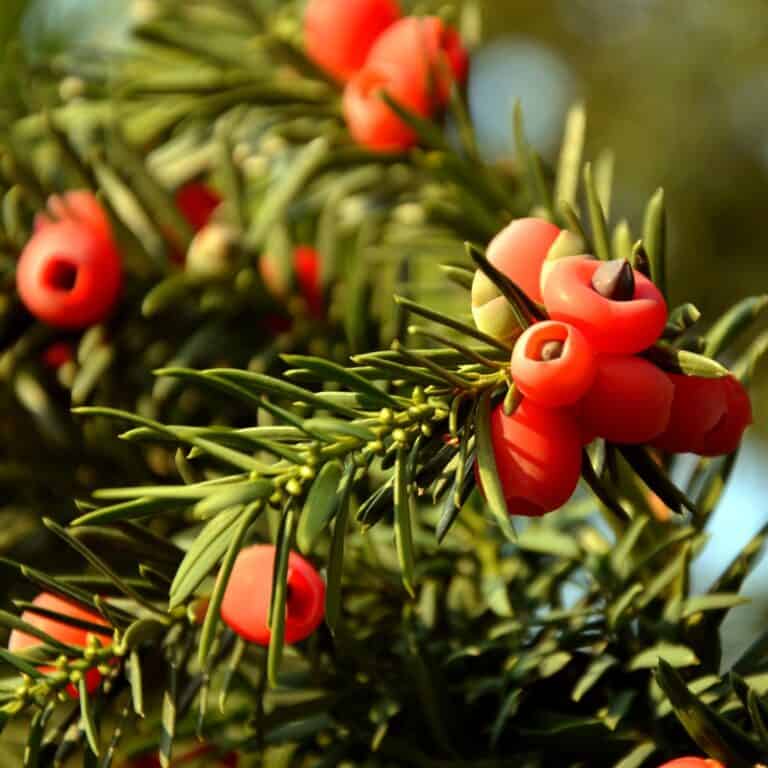
4. Yew Berries (Taxus Baccata)
Yew trees are native to parts of Europe, Africa, Iran, and Asia and are grown mostly as ornamental trees. These are highly poisonous with consumption usually resulting in death.
With the exception of the red flesh of the berry, every part of this tree is poisonous; containing taxine alkaloids which affect the heart. Yew poisoning is quite common among animals and while there is no antidote for it; the symptoms can be treated.
The estimated lethal dose for humans is 3mg/kg of body weight or 50g of yew needles. Consuming a lethal dose of yew needles causes cardiogenic shock (your heart malfunctions and can’t pump enough oxygenated blood to your vital organs) resulting in death.
5. Virginia Creeper Berries (Parthenocissus Quinquefolia)
Native to eastern and central North America, Mexico, and Guatemala, the Virginia creeper is grown as an ornamental plant. It’s a vine that tends to climb up a wall/surface and it’s noted for its ability to cover a surface and its attractive fall foliage.
The berries from this plant are a purple-black color and aren’t toxic/poisonous to birds. In fact, they form an important food source for some bird species but are highly toxic to humans.
The berries contain lethal amounts of oxalic acid which causes kidney damage and death in humans.
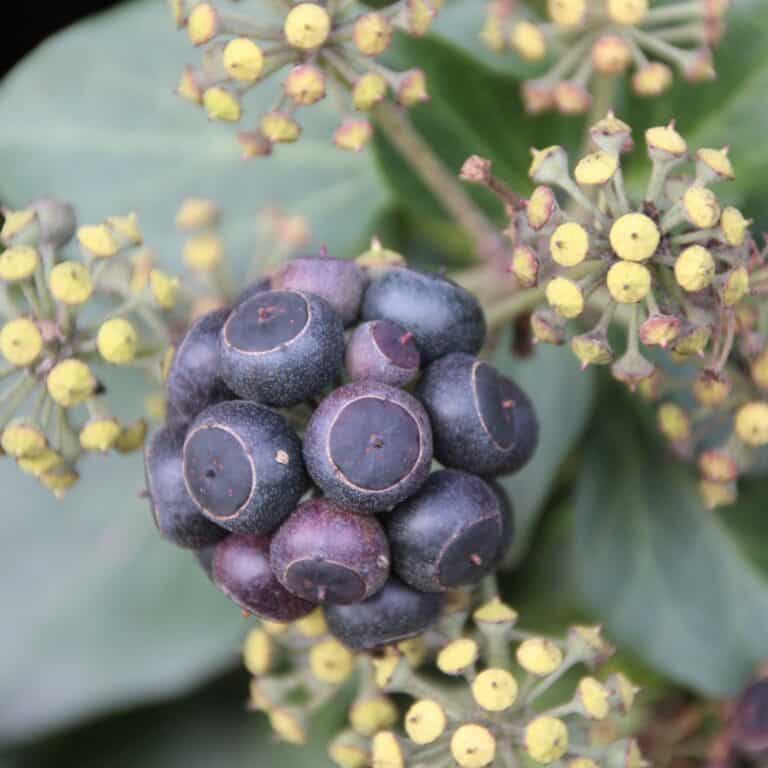
6. Ivy Berries (Hedera)
The Hedera or ivy family consists of 12 – 15 species of plants native to Europe, Macronesia, Northwestern Africa and parts of Asia. Ivy vines are a common sight here in South Africa, you find them spreading across flat ground and climbing up the walls of buildings.
The berries produced by these plants are moderately toxic and cause contact dermatitis – a skin rash. It’s not life-threatening, but it can be very, very uncomfortable.
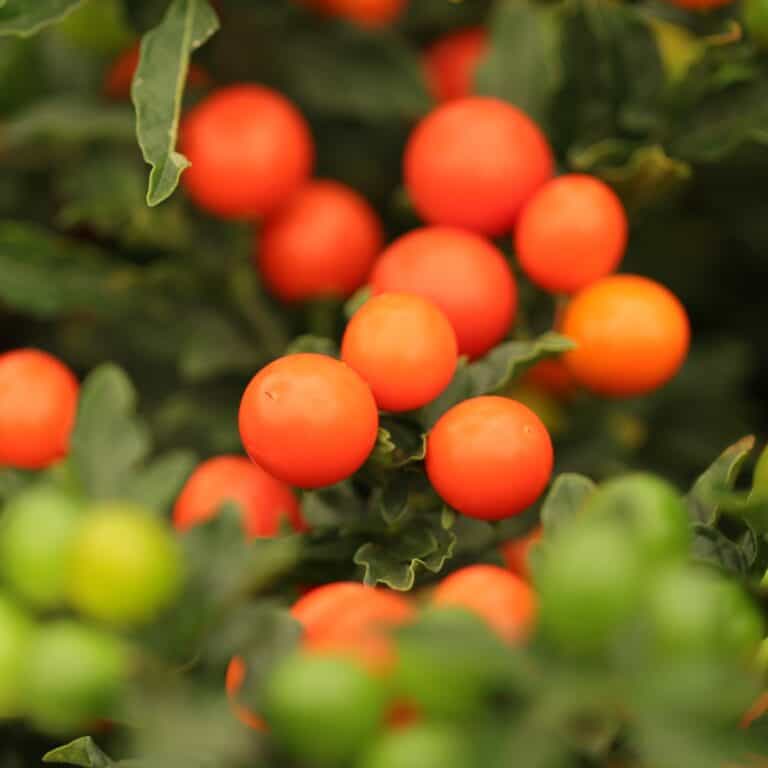
7. Jerusalem Cherries (Solanum Pseudocapsicum)
Native to Peru and Ecuador, the Jerusalem cherry is a member of the nightshade family. They live for up to 10 years and produce fruits extremely similar to cherry tomatoes in texture and flavor – resulting in the two being confused for each other.
The Jerusalem cherry contains solanocapsine which, while toxic, is usually not life-threatening. It tends to cause stomach pain, diarrhea, and vomiting.
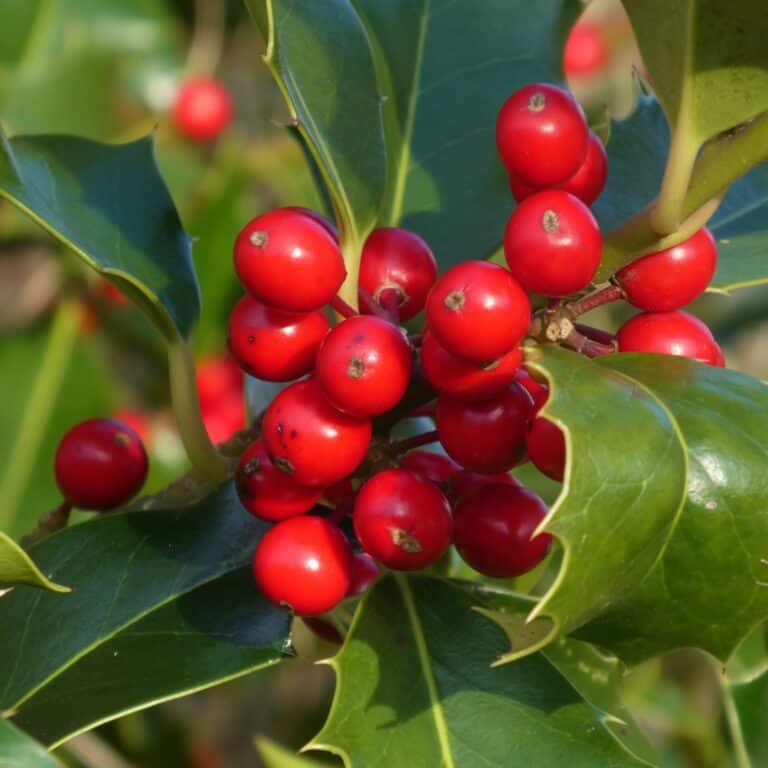
8. Holly Berries (Ilex Aquifolium)
There are 500 species of holly plant, and you can find them all over the world in temperate climates. The European variant is used for Christmas decorations and cards.
Holly contains a variety of substances including caffeine, caffeic acid, chlorogenic acid, and theobromine. These substances make the berries toxic, they cause diarrhea, nausea, vomiting, and stomach and intestinal problems.
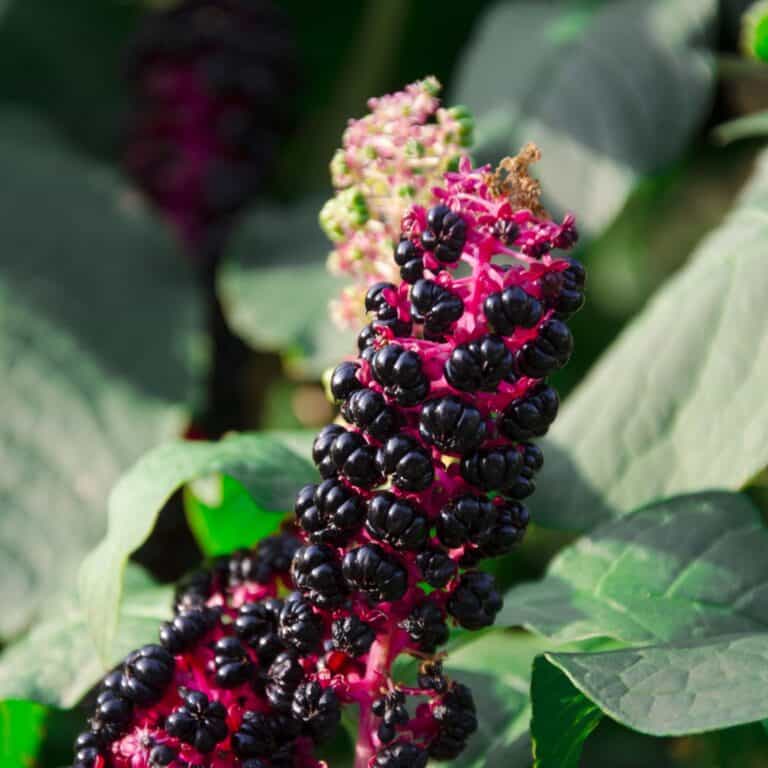
9. Pokeweed Berries (Phytolacca Americana)
Pokeweed…this is one of those plants where you’ll get conflicting information. Some articles say that if you prepare it properly and you’re only using the young shoots that appear in the springtime, it’s safe to eat.
Others say that you shouldn’t even touch the stuff! The berries can stain the skin and they contain phytolaccine proteins which can damage the digestive and respiratory systems. Ingesting these berries or having prolonged physical contact with them can also cause skin rashes, nausea, vomiting, stomach pain, and loss of bowel control…lovely.
If these proteins get into your blood, it’s even worse; symptoms include headaches, convulsions, muscle spasms, weakness, difficulty breathing, low blood pressure and, in some cases, loss of consciousness.
10. Deadly Nightshade (Atropa Belladonna)
Atropa Belladonna, also called Deadly nightshade is native to Europe, North Africa, and West Asia. It’s one of the most toxic plants in the Eastern Hemisphere.
How dangerous is it? Well, the maximum single dose for human consumption is 200mg but the consumption of between 2 and 5 berries is enough to kill an adult human.
Belladonna poisoning symptoms include constipation, delirium, confusion, light sensitivity, urinary retention, staggering, lack of balance, rash, and hallucinations among other things.
Fun Fact: The name ‘belladonna’ comes from its historical use by women. The name means ‘beautiful woman’ in Italian and drops prepared from the plant were used to dilate a woman’s pupils; dilated pupils were considered attractive.
11. Canada Moonseed (Menispermum Canadense)
‘If it looks like a duck, swims like a duck, quacks like a duck; it must be a duck.’ – except when you’re dealing with plants. Just because it looks like a grape, doesn’t mean it IS a grape. Making that mistake with this one could be tragic.
The Canada Moonseed is found in the eastern part of North America, and southern Canada, you can also find it in Florida, and Texas.
They have a strong resemblance to grapes, so much so that they are easily mistaken for them. The name ‘moonseed’ comes from the shape of the berry’s seed – a crescent moon and the fruit is ripe between September and October (the same time as wild grapes).
They contain an alkaloid called dauricine and, if eaten, can be fatal.
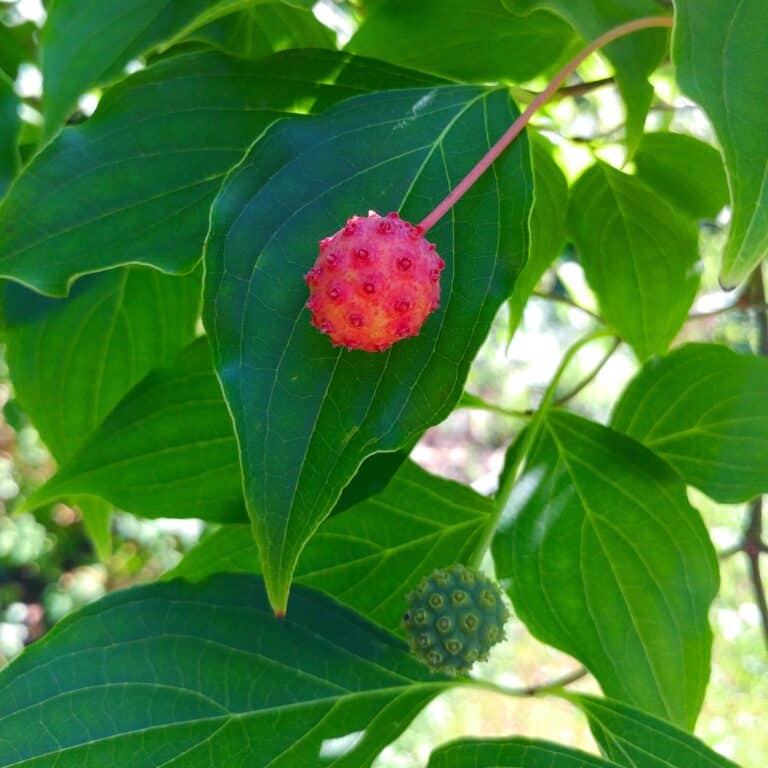
12. Dogwood Berries (Cornus)
These small, red berries are typically found between forests and field in the eastern United States in the fall and winter. They are commonly eaten by birds, and some are edible but humans should leave them alone just to be on the safe side.
13. Horse Nettle (Solanum Carolinense)
Horse nettle is a member of the Solanum (nightshade) family and bears a striking resemblance to a tomato. The fruits are a green or yellow color and resemble a cherry tomato.
Most parts (fruits, leaves, etc.) of the plants are poisonous, containing solanine – a toxic alkaloid which, upon consumption, causes abdominal pain as well as circulatory and respiratory problems.
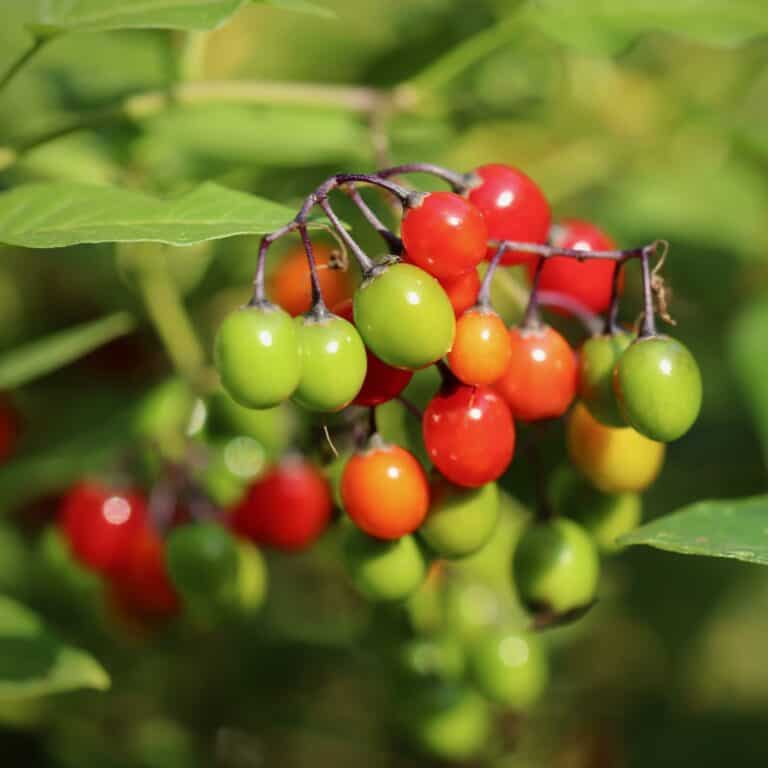
14. Bittersweet Nightshade (Solanum dulcamara)
The bittersweet nightshade is native to Europe and Asia and has been naturalized in many parts of the world – including North America. It’s a creeping vine that can reach up to 4m in height – if a strong enough support system is in place.
The presence of toxic alkaloids (solanine, solasodine, and beta-solamarine) make it highly poisonous to humans.
Human poisonings and fatalities are rare, but they do happen.
Fun fact: Bittersweet nightshade plants were hung around the necks of cattle during the Middle Ages to protect them from the evil eye and witchcraft.
15. White Baneberry (Actaea pachypoda)
The white baneberry is native to the eastern parts of North America and prefers loamy soil and shady places in which to grow.
The nickname ‘doll’s eyes’ comes from the small 1cm berries are white with a black dot in the middle, like a doll’s eyes. Every part of this plant – particularly the berries – is poisonous to humans.
White baneberries contain cardiogenic toxins which can have an immediate sedative effect on the muscular tissue of the heart.
A toxic dose induces symptoms like salivation, diarrhea, dizziness, severe stomach pain/cramps, headaches, and hallucinations. The ultimate result of ingestion can lead to death by cardiac arrest (heart attack).
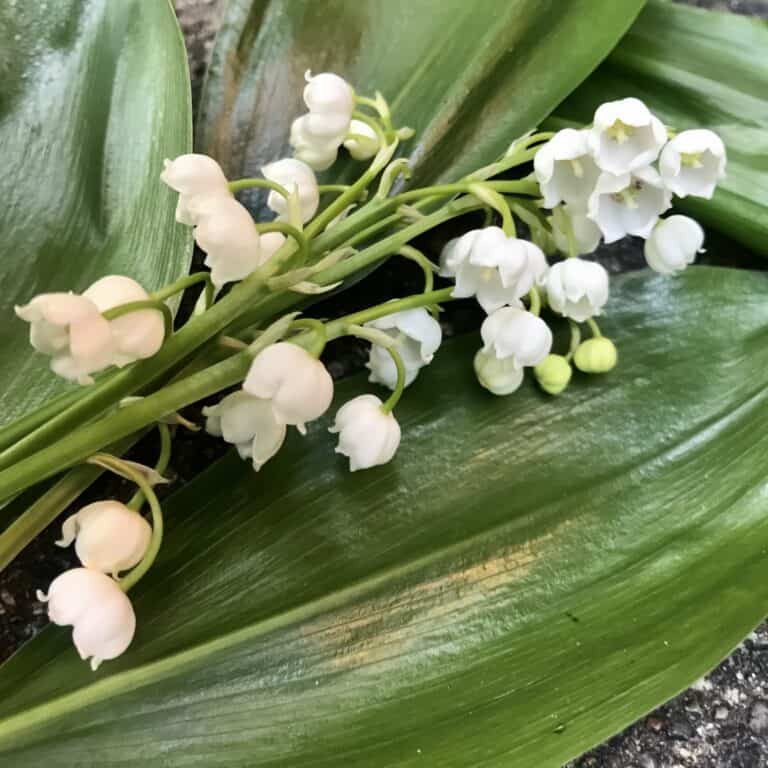
16. Lily of the Valley (Convallaria majalis)
It might just be me, but this one looks a bit like a cherry or a tomato which makes confusion for something edible an understandable mistake. The lily of the valley is found in Asia, Europe, and the southern Appalachian Mountains of the United States.
Growing to between 15 and 30 centimeters in height and sporting between 5 and 15 sweetly scented flowers, the red-orange berries on this plant are highly poisonous.
Even small amounts of these berries can cause abdominal pain, vomiting, confusion, and reduced heart rate. The lily of the valley has been found to contain 38 different cardiac toxins which can cause cardiac arrest and death.
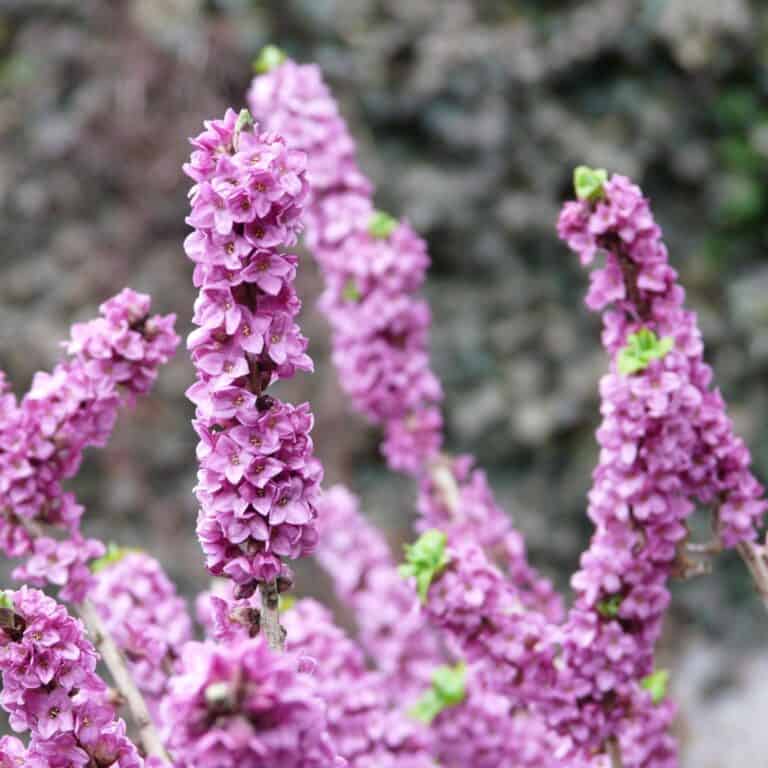
17. Daphne
Daphne is a family of evergreen shrub found in North Africa, Asia, and Europe consisting of around 95 species. They’re noted for their scent and brightly colored berries. All parts of these plants – especially the berries – are poisonous.
Mezereon (Daphne Mezereum)
Mezereon is one of the members of the Daphne family that’s found primarily in Europe, western Asia, Scandinavia, and Russia. It grows to 1.5 meters tall and has a bright red berry which is highly poisonous to humans.
The berries and twigs contain mezerein and daphnin which make them highly toxic. Poisoning symptoms include a choking sensation followed by nausea, headaches, abdominal pain, and diarrhea. Ingesting only one or two berries will cause an upset stomach and eating more than that can be fatal.
Flax-Leaved Daphne (Daphne Gnidium)
Flax-leaved Daphne is indigenous to the Mediterranean. It has dark green foliage with fragrant white flowers and an orange-red berry which is produced in the fall. Much like the Daphne Mezereum, all parts of Flax-leaved Daphne are highly poisonous.
Skin contact with the sap causes dermatitis, while ingestion will cause severe anabolic and digestive reactions. The odds of death are small but typically will occur within six hours of consumption.
In short, Daphne is dangerous!
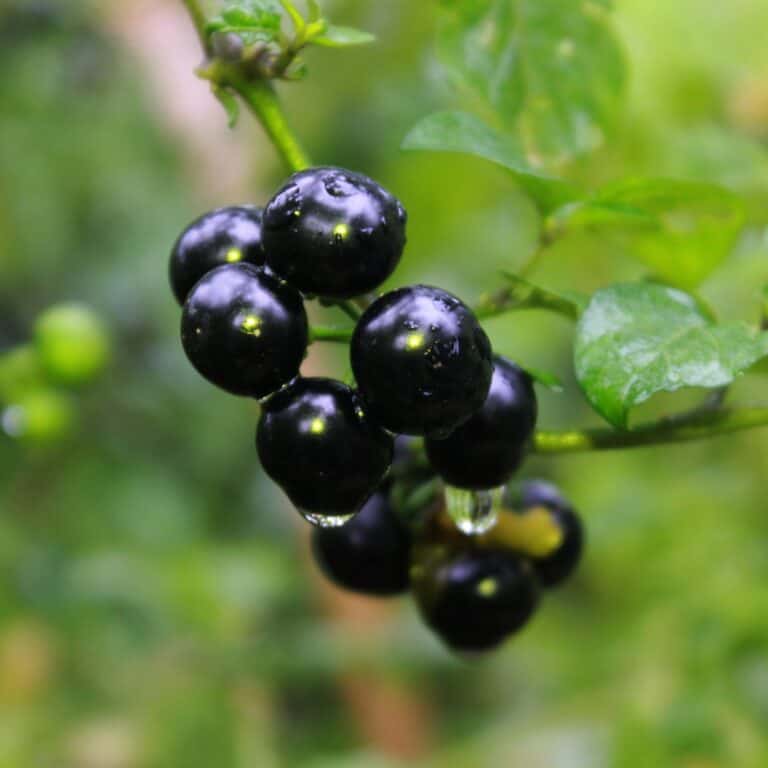
18. Black Nightshade (Solanum Nigrum)
Also called blackberry nightshade, black nightshade is native to Eurasia but can be found in the Americas, Australasia, and South Africa. There are many types of black nightshade, some of which are edible.
The berries produced by black nightshade are typically between six and eight millimeters in diameter and black or purple black in color. It is sometimes mistaken for its deadlier relative Atropa Belladonna (deadly nightshade).
Black nightshade contains solanine, high levels of which can be toxic, but fatalities are rare. Symptoms are delayed for six to twelve hours after ingestion but include fever, sweating, vomiting, abdominal pain, diarrhea, and drowsiness.
Eating large amounts of berries can cause cardiac arrythmias and respiratory failure leading to death.
19. Red Baneberry (Actaea Rubra)
There are two species of baneberry that are found in North America, we’ve already discussed white baneberries (Actaea Pachypoda), now let’s look at the red baneberry.
Also called snakeberries, red baneberries are found throughout North America and Canada and are most often encountered by hikers.
The plant blooms from May throughout June with the flowers dying in the fall and forming clusters of red, juicy-looking berries. They have a bitter flavor and eating them causes a burning sensation in the throat and mouth – so most people will only eat one.
Common effects of consuming red baneberries include dizziness, stomach cramps, diarrhea, headaches, and vomiting. Just six berries can cause cardiac arrest and/or respiratory distress.
With that said, birds and animals love them.
20. American Bittersweet (Celastrus Scandens)
Also colloquially called Jacobs Ladder, the American Bittersweet is found in most of North America and Canada.
These are very vibrant, beautiful plants which produce berries which are eaten by various wildlife but are highly toxic to humans. Every part of the plant is poisonous and causes vomiting and diarrhea.
The American bittersweet is declining in North America because of its popularity in floral arrangement.
21. Oriental Bittersweet (Celastrus Orbiculatus)
The oriental bittersweet is a relative of the American bittersweet and readily hybridizes/pollinates with it. It has a very distinctive look and is a popular ornamental plant.
Oriental bittersweet has distinctive green flowers and is considered an invasive species due to how it can choke/take over a space. Much like its American counterpart, all parts of the oriental bittersweet are poisonous.
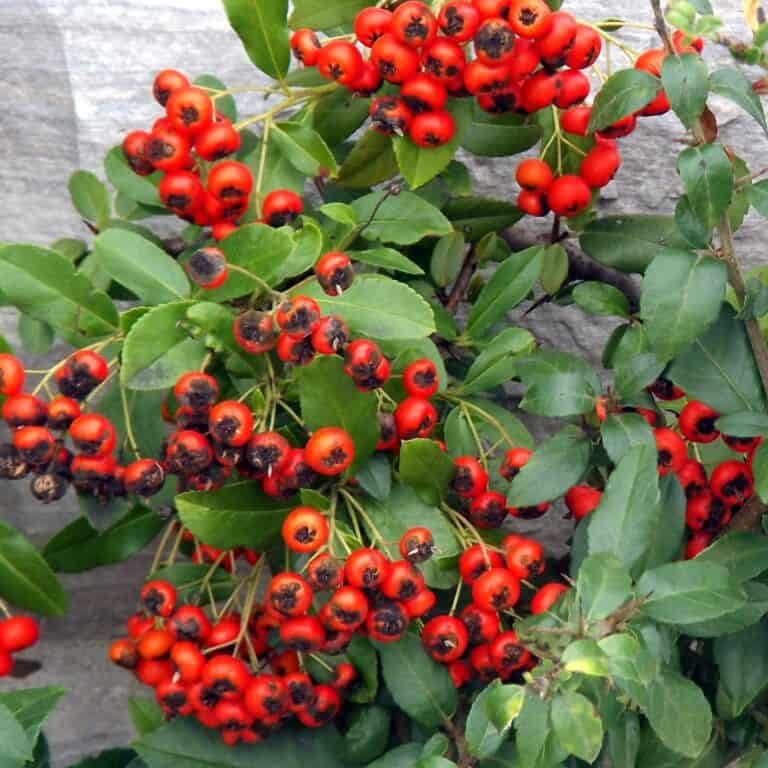
22. Cotoneaster (Cotoneaster Frigidus)
A member of the Rose family native to Asia, Europe and North Africa, cotoneaster berries are eaten by moths, and various types of birds. Bees also love them because of the nectar produced by the flowers.
All parts of these plants are poisonous to humans, and eating them will affect the heart, kidneys, liver, and/or brain. The berries contain cyanogenic glycocides – toxins which convert to cyanide during digestion.
Thankfully the concentration of these toxins is quite low which means that an adult would have to eat a large quantity to experience serious symptoms. Children are at greater risk of a stronger reaction.
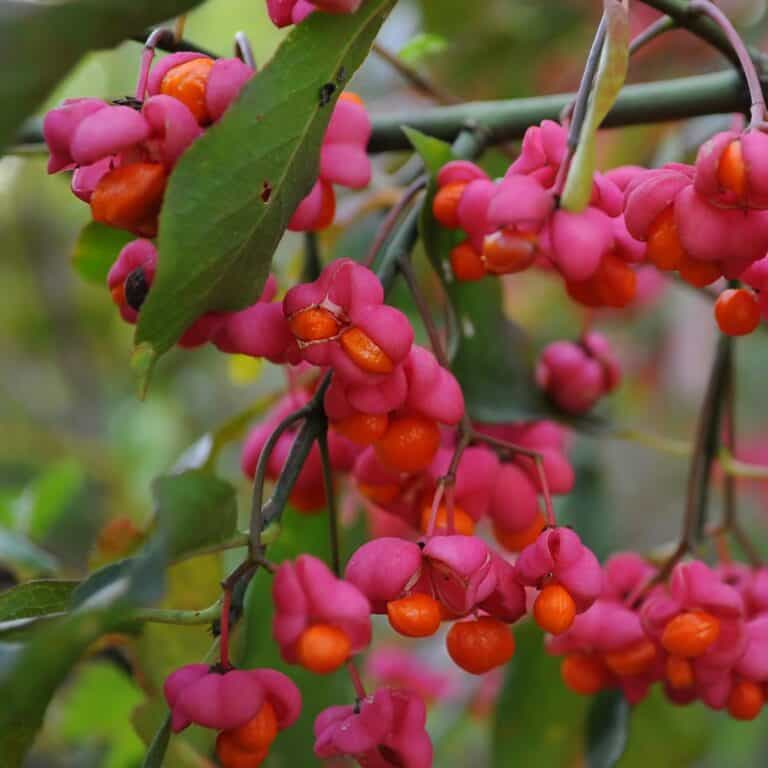
23. European Spindle (Euonymus Europaeus)
Also called spindleberries, European spindle plants are found all over Europe and parts of North America. The berries are pink, pumpkin-shaped things which contain several poisons: glycocides, evobioside, and evomonoside.
These toxins cause nausea, vomiting, stomach pain, and diarrhea. In more serious situations, poisoning causes kidney failure, unconsciousness, and, possibly, death.
The lethal dose for an adult is 30 berries but for children that number is much lower.
24. Poison Sumac Berries (Toxicodendron Vernix)
Poison sumac is found throughout North America growing in very wet soil around swamps and streams. The trees grow to 30 feet in height and produce small white berries which contain a toxin called urushiol.
Physical contact with poison sumac causes skin irritation and while eating a few may not kill you it will cause nausea, vomiting, respiratory problems (damage to the lungs), and general discomfort.
25. Chokecherry (Prunus Virginiana)
Also called the Virginia bird cherry, the chokecherry is native to North America and most of Canada. Chokecherry trees are popular shade trees known for wide canopies and interesting shapes. The trees produce red or black berries which are very attractive to the eye.
Now, the fruit itself is fine but the seed contains glycoside – a toxin similar to cyanide. With that in mind, eating large amounts can be deadly. Poisoning symptoms include vomiting, high blood pressure, headaches, and dizziness.
26. Jack in the Pulpit (Arisaema Triphyllum)
Jack in the pulpit…that’s quite a unique name and its flower is just as unique; a tubular thing slightly resembling a bell. It’s native to North America and can grow up to 65 centimeters in height.
The plant itself is perfectly safe to handle BUT the berries it produces are highly toxic. The plant contains calcium oxalate, and the berries contain oxalic acid with is poisonous when eaten.
These substances cause a burning sensation and irritation in the mouth and digestive system. Occasionally, they cause blisters and swelling in the mouth (which can affect breathing in some cases).
27. Burning Bush (Euonymus Alatus)
Native to northern China, Japan, and Korea, burning bush gets its name from its bright red fall colors. The attractive fall colors and brightly colored fruits make this a popular ornamental plant for parks and gardens.
With that said, it’s considered an invasive species in North America and as such importing and selling it is illegal in Massachusetts, New Hampshire, and Maine.
Its popularity as an ornamental plant has made this a threatened species. All parts of this plant are toxic, and ingestion will cause severe discomfort.
A Few Last Words of Warning
When it comes to wild berries, one should always exert extreme caution. If you don’t know exactly what it is, don’t eat it. If you have children, you should keep a close eye on them, and make sure they know not to eat weird plants they find in the garden or on hiking trails.
Keep in mind children don’t eat one thing at a time; they’ll eat handfuls of berries – which could be tragic if what they’re eating is poisonous.
In closing, I hope you enjoyed the article and found it informative. As always, thanks for reading and I’ll see you for the next one very soon. Take care!
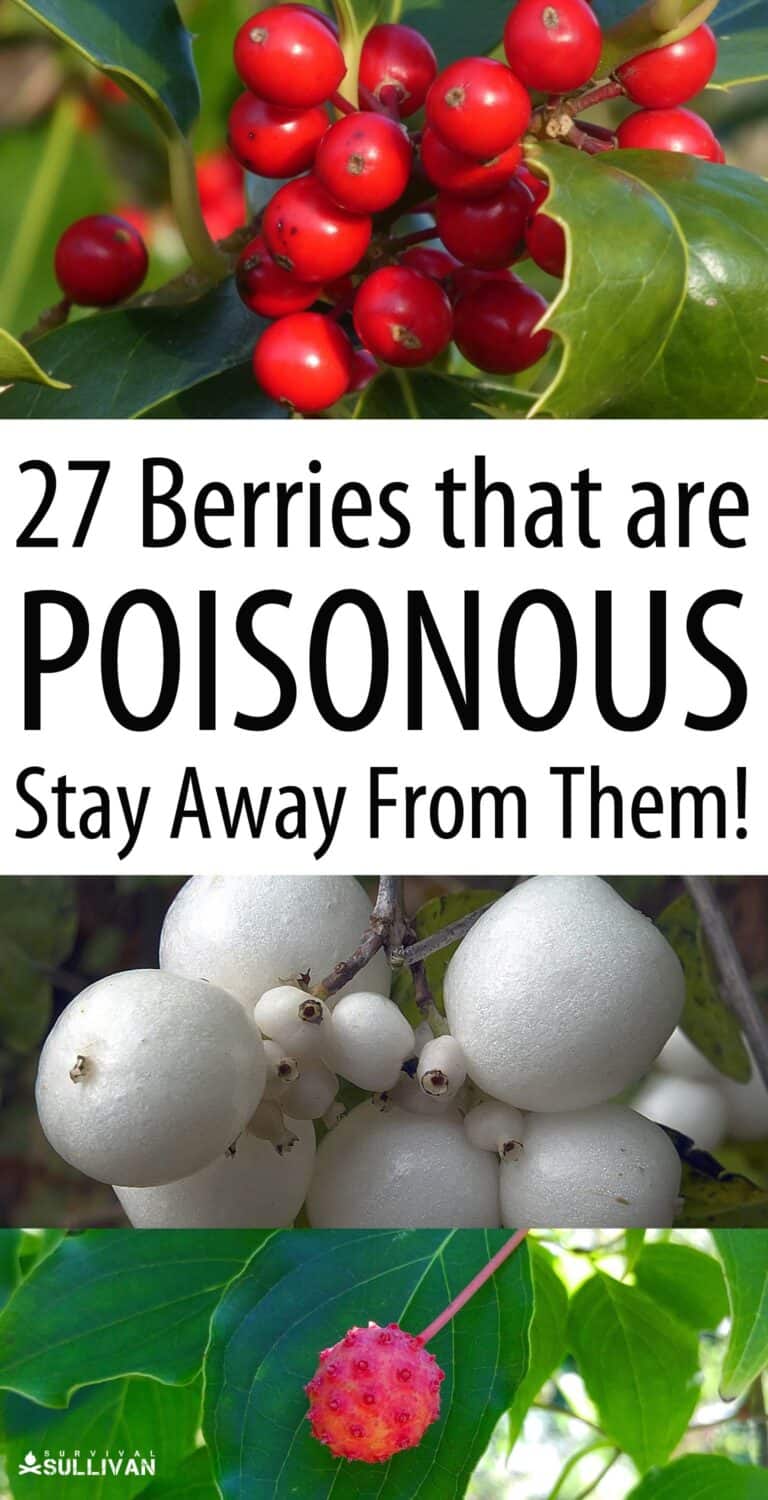
[ad_2]
Source link
Get more stuff like this
in your inbox
Don't Be Left Unprepared
Thank you for subscribing.
Something went wrong.





